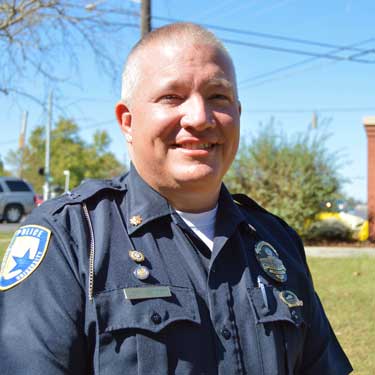Story by Kayla Harrell, Staff writer

Assistant Chief Jeff Gentry and Public Safety held active shooter training for faculty and staff.
Public Safety and Emergency Management held active shooter training sessions for all faculty and staff this year in Wrather West Kentucky Museum.
The active shooter training used PowerPoints to teach the faculty and staff what to do in these situations.
Allison Adams, sophomore from Madisonville, Kentucky, said, “The lack of hands-on training makes me feel like the campus is not thoroughly prepared to handle a situation where there is a threat of an active shooter.”
The active shooter training for the faculty and staff was filmed and released on Murray State’s active shooter training page under emergency procedures on April 23, 2015.
“The residential advisers and residential directors receive the same training as faculty and staff,” said Interim Chief of Public Safety Roy Dunaway. “Students are encouraged to watch the video because the training applies to anybody.”
Jackson Castleberry, freshman from Benton, Kentucky, said Murray State “should have a computer oriented informative or training session for students just like AlcoholEDU and Title IX.”
Active shooter incidents, such as the Umpqua Community College shooting in Oregon and the Sacramento City College shooting in California, have added to preexisting conversations about safety across the country, increasing the need for training on actions to take if this were to happen at Murray State.
If an active shooter is on campus, the university would not be on “lockdown.” Dunaway said that it suggests that the university is locking out potential victims. Instead, the term would be “shelter in place.”
In the situation of an active shooter nearby, the three options are run, hide or fight.
“It may start out as run, turn into hide and then turn into fight,” Dunaway said.
RUN IF POSSIBLE
Dunaway said individuals are encouraged to run if at all possible.
In the active shooter training video, Dunaway said, “If the sound of gunfire is far away, one option is to move away from the sound.”
Consider the following before running from the shooter:
- If those around you could move to an agreed upon location chosen away from the immediate danger.
- How quickly can you create distance?
- Could you cross paths with the aggressor?
- Is there more than one aggressor?
Once the individuals exit the building, the next step is to call Public Safety at 270-809-2222 or 911 and provide details of the situation, according to Murray State’s active shooter training webpage.
HIDE, BUT DO NOT SEEK
If an individual can’t run, the next option is to hide from the aggressor. When hiding, take precautions:
- Lock the door(s) to the room
- Barricade the door
- Shut off the lights
- Keep out of sight
- Silence all cell phones
- If possible, discretely report aggressor’s position
Individuals hiding from the aggressor might be asked to stay put when law enforcement gets to the scene.
Dunaway said in the video, “Notifications of a lockdown being lifted will be made on the IP phones, outdoor notification system, text messaging and social media.”
FIGHT FOR YOUR LIFE
The last option is to take out the aggressor, which is the least preferred, according to the video. If fighting is the chosen option:
- Throwing objects can disable the aggressor and hamper the ability to aim a weapon
- Yelling can surprise and disrupt the thought process
- Swarming the aggressor is often effective, resulting in the aggressor being knocked down and disarmed
- More likely to succeed if done by larger groups
- Move the weapon away from the aggressor and secure it
- Picking up the weapon may result in law enforcement mistaking you for the aggressor
“All you need is one second of distraction,” Dunaway said.
TRUST THE AUTHORITIES
Public Safety trains every year for situations such as active shooters on campus. Several of the officers are certified to be trainers.
“This year, for example, we had the Kentucky State Police SWAT team train us on how to handle an active shooter, Dunaway said. “We spent a whole day with four of their members clearing rooms and how to handle an active shooter safely.”
The safety of students, faculty and staff is a priority for Public Safety.
“Be aware and be prepared,” Dunaway said. “At the end of the day, we want you safe.”